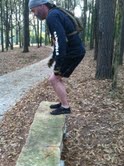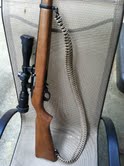by Todd Walker
It’s trendy to forecast and prognosticate TEOTWAWKI and other SHTF events.
We need to know what’s coming so we can make a plan to survive the event.
Here’s the hitch: they’re rarely right. And even if they are right, will our plan save us?
Every time I hear of a doomsday event coming, Y2K, and more recently, the Mayan calendar expiring, I chuckle and keep doing the stuff.
Prognosticators sit in ivory towers predicting major events and fail to highlight the predictable. Entranced by their babble, we stumble over all the random, overlooked (non-glamorous), predictable bumps on our preparedness journey.
Why?
We’re all scared of the big event.
The Crunchy Mama recently commented here that she used to be guided by fear. She wrote…
I LOVE that you are a positive prepper. I lived in fear for many unhappy years. I finally made my way out of the fear with the help of God and some people who were God-sent. I figured out that I could be a prepper and be happy and positive. I put my energy into doing things that I really love but I no longer do them out of fear.
Don’t confuse her positive prepping with a Pollyanna view full of whirled peas, rainbows, and flying unicorns. She’s aware of the fragility of the systems we live under and is taking steps to escape the insanity. And she’s enjoying her journey.
Fearing the collapse of said system was the catalyst for many of us to start our journey to self-sufficiency.
However, the problem begins when fear chokes out rational thought and strangles our vision for the future. At that moment, a fear-based preparedness plan becomes as fragile as the system in collapse mode.
No matter what the pundits tell you, the big events aren’t accurately predictable. Even though you see the waves and hear the ship moaning, you still don’t know when it will splinter and sink.
Don’t count on the captain to save a life raft for you. Build options into your plan. And this is not referencing Capt. William E. Simpson of The Nautical Prepper. I actually think he may have a great SHTF plan.
Back to us land locked folk. Here’s something to think about: What’s Mother Nature going to do next to make your life miserable?
Nature is a brutal school master. Just when you have your plan set in stone, that flood, or hurricane, or drought shreds your paper plan. If you’re not room temperature afterwards, they say it makes you stronger.
And we’re not even considering man-made brutality yet.
I have no idea if our grandiose SHTF plan will succeed or fail. I’m just not that smart. Plus, I’ve never experienced a collapse of everything. I don’t know anyone that has personally experienced TEOTWAWKI in the hyped Hollywood version we all dread.
We make our plans anyway. We want to insure against the big one – the collapse of society/government/the world/TEOTWAWKI, and hope the smaller events take care of themselves.
But they don’t. We may have it bass ackwards.
Maybe, just maybe, we should focus on the smaller, obvious things.
Prisoner of the Plan
So, you put together a plan with an end in mind. Then, those 11 little words of Robert Burns begin to haunt you, inconveniently.
“The best laid plans of mice and men often go astray”
The illusion of knowing where you’re going and how to get there is dangerous. Especially when you believe others know how to get you there and they haven’t been there themselves.
In the story laid out in Patriots, plans don’t always work out. Mr. Rawles made it crystal clear in this novel the importance of redundancy in our plan. Mother Nature and tyrants don’t care about your plan. Unknowns make us fly by the seat of our pants.
It’s the unknown unknowns that compel invention. We find better/improved ways to do the stuff. We find freedom by doing, tweaking, and tinkering.
Being a prisoner to your plan is like paying for a tour guide to show you a historic city. You’re locked into the agenda, predetermined destinations, and sights she thinks are important for you.
Your options to self-explore are severely limited or nonexistent.
Optional Tips on Options
These are some off-the-cuff ways to add options to your SHTF plan.
A.) Procrastinate. Easily the most vilified word in the prepper community. It’s akin to laziness, sloth, and sheeple.
I’m being serious. Procrastination can be useful in some instances. I certainly don’t recommend it for an immediate life and death situation. If some thug breaks my door down, he gets immediate attention. No lollygagging.
On the other hand.
You’re ready to pull the trigger on that piece of remote retreat/farm land. It’s seems perfect. But you drag your feet. Someone swoops in and buys it while your thinking it over. You wife is fuming. Your sleeping on the sofa.
A month later, while licking your wounds in your new sleeping arrangement, she humbly shares information about the property that proves it wasn’t right. Sometimes we benefit by putting off ’til tomorrow what we absolutely think we have to do today.
Beware of the tyranny of the urgent.
B.) Random Acts of Prepping. Randomness teaches us how to be flexible and resilient. It’s the random events that test our ability. Are we able to cope? Do we rebound and stay the same? Or do we get better?
Your options multiply when we embrace randomness. Accidentally, it seems, you stumble upon situations and people who are a better fit than your original master plan.
So, go to that meet up and mingle with random people. You never know…
C.) Your SHTF plan and reality aren’t the same thing. Unless you’ve gone through all out SH’ingTF, how do you know the plan will work? Now is the time for controlled stress-testing to see if the plan (and you) can hold up.
In theory, bugging out on foot to the hills seems like a good idea – if you had to. Humping a 72 hour go back (in practice) is different and more difficult than the preparedness books lead us to believe. Have you tried it?
“Preparedness is the adult response to the knowledge that sometimes, at some level, things go haywire.” [Lifted from the blog For Tomorrow We…]
A recent post over on For Tomorrow We… (72 Hours in Just Five Minutes) outlines a great way to stress your plan. Simple and safe – yet revealing.
D.) Less is more. This is obvious to those of you doing the stuff. In my field full of ‘intellectuals,’ educators with lots of letters in front and behind their names, we can’t seem to grasp this idea. There’s too much thinking and not enough doing. Don’t over think your plan.
Simplify you plan. Brilliance is simple.
E.) Tinker. The best preparedness plan won’t come to you in your LazyBoy recliner. Might as well tinker and find options that will minimize the downside and boost the upside – without life threatening risks.
F.) Trial and error. In real life, not in a sterilized classroom or book, our best lesson is our last mistake.
Dirt Road Girl and I have emergency plans. We’re not obligated to follow what’s outlined. But we can choose that plan if we need to. Don’t marry your plan! Keep playing the field looking for the best options.
If you’re thinking I’m anti-SHTF-planning, you’ve missed my point. What I tried to communicate is…
The best SHTF plan has to be shaken well before opening.
The last thing you want is to be a prisoner of your plan.
Doing the stuff,
Todd
Related articles
- Anti-Fragile Strategies for SmartPreppers (survivalsherpa.wordpress.com)
- Large-Scale Disaster: A Sobering Problem – Requiring A Different Approach (thedailysheeple.com)



































